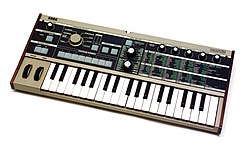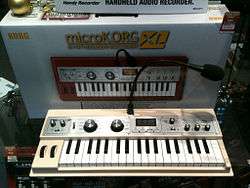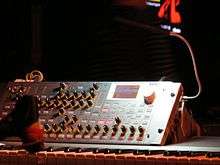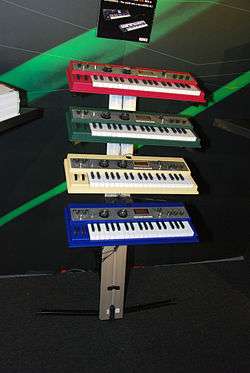microKORG
The microKORG is a MIDI-capable virtual analog synthesizer/vocoder from Korg featuring DSP analog modelling. The synthesizer is built in such a way that it is essentially a Korg MS-2000 with programmable step arpeggiator (MS-2000 has only six simple patterns), a less advanced vocoder (8 bands instead of 16 bands found on the MS-2000), lack of motion sequencing (MS-2000 had three motion sequences), lack of an XLR microphone input, and in a smaller case with fewer real-time control knobs.


The microKORG was released in 2002 and is still in production as of 2020. It is considered one of the most popular music synthesizers in recent history,[1] with estimated 100,000 units sold as of May 2009. In September 2007 Korg released a limited edition of the microKORG with reverse-color keys although the functionality was otherwise unchanged. At NAMM 2008, a successor called the microKORG XL was introduced.[2] Available since early 2009 it uses MMT Multi Modeling Technology from Korg's newer and more powerful Radias/R3 synthesizers.

.jpg)
Synthesis
The microKORG uses DSP technology to emulate the sounds of an analog synthesizer using firmware, and is based around the same engine found in the Korg MS2000. The fundamental unit of sound is, in Korg's terminology, a "timbre". This is generated with a pair of multi-function oscillators. Two timbres can be combined to create a four-oscillator "layer". This can be used to create more complex sounds, although it halves the polyphony from four notes to two. A single timbre can be played in four-voice.[3] Oscillator one (OSC1) can produce one of several fundamental waveforms, including saw, square, triangle, and sine waves. Alternatively, OSC1 can produce a vox wave (for simulating human vocal cords), white noise, and one of 64 different digital waveforms that were created by harmonic additive synthesis. Some of these 64 waveforms were originally featured in the Korg DW-8000 digital synthesizer of the mid 1980s. The second oscillator (OSC2) is limited to saw, square, and triangle waveforms.
Each waveform on OSC1 has a unique modulation feature, including wave morphing, Pulse-width modulation, and FM. OSC2 can be detuned, synchronized, and/or ring-modulated with OSC1 in order to create more complex sounds. OSC1 can also be replaced with the signal from one of the line-level inputs on the back of the unit, allowing external signals to be processed with the effects and filters of the microKORG, or potentially ring-modulated by OSC2.
The microKORG utilizes filters such as Low Pass (-12dB/Oct and -24dB/Oct), Band Pass (-12dB/Oct), and High Pass (-12dB/Oct).[4]
The microKORG also uses effects such as flange, ensemble, phaser, and digital delay, which can also be applied to external signals. The unit also features two independent LFOs, with six different waveforms, which can be used to create more complex modulations.
When playing a single timbre, the keyboard utilises four-voice polyphony. In layer mode it generally has two-voice polyphony, although one combination of polyphonic/mono layers allows for three-voice polyphony of the second timbre.
The microKORG groups its 128 factory preset sound patches into 8 groups:
A large knob changes the selected sound group. Each group has 16 different patches (two banks of eight), selected by the eight lighted buttons on the front with a side A/B button to toggle between sets of eight. All patches are user editable, and do not necessarily have to follow the groupings listed on the face plate.
microKORG XL

The direct successor to the microKORG, the microKORG XL, utilises MMT Analog modelling, and is based on Korg's own R3.[5] The XL features a brand-new LCD display, and two Program Select knobs for easier access.
The microKORG XL groups its 128 factory preset sound patches into 8 groups:
and several sub categories:
New features specific to the microKORG XL
Notably, the microKORG XL features 17 different KAOSS derived effects, including phaser, flange, decimation, vibrato, tremolo and retrigger. The XL also features several included PCM Waveforms, including Piano, Brass Ensemble, nine Electric Piano and Clavinet, seven organ sounds (one of which emulates the Korg M1 Organ), a full String Orchestra, two variable formant waves and more than 32 digitally generated waveforms (SYNWAVE 6 is a ramp wave/inverted sawtooth.) The XL adds two additional Waveform Modulation types: Phase Modulation and Unison (in which five stacked oscillators within 1 oscillator can be detuned and phased to achieve a richer sound.) The Unison Simulator is similar to the Supersaw waveform on the Roland JP-8000. The included "OSC MOD WAVEFORM" and "OSC2 SYNC" controllers are reminiscent of the Poly-Mod feature in the Sequential Circuits Prophet-5. The microKORG XL also includes a waveshaper (uncommon in most synthesizers) which will morph the current waveform into an approximation of the waveform desired, resulting in a harsh sound. The waveshaper also includes a third oscillator (Sub oscillator.)
Additional improvements include:
- Polyphony increased up to eight notes
- Vocoder increased to 16 bands, but still supports the 4 note polyphony
- USB connector for MIDI over USB operation
- "Split" and "Multi" added to Voice modes
- The option to use ten scales, including one defined by the user.
- "Analog Tune" simulates the pitch instability and oscillator “drift” that was characteristic of vintage analog synthesizers
Korg RK-100S
In 2014, Korg announced the RK-100S keytar, which is essentially a 37-key "keytar" version of the microKORG XL+, with many external differences and only two internal differences. On the inside, it sports the same exact features as the MicroKorg XL+, except it has 200 program storage instead of 128, and allowing for the long ribbon controller to serve as a modulation source. Externally the RK-100S is radically different. It lacks the ability to edit programs from the unit; editing may only be done via a control app available for Mac and PC (or, if one is daring enough, it is technically possible to create ones own editor using the available MIDI messages chart). MicroKORG XL and XL+ patches may be downloaded into the unit one-by-one or en masse, allowing patch editing to be done on a microKORG XL+.
Notable external differences of the RK-100S
- lacks the XLR mic input and dual quarter-inch mono output jacks of microKORG XL+, instead featuring a stereo 1/4" TRS jack and mono 1/8" audio input jack, switchable between three gain levels (Line, Mic1, Mic2)
- adds a short and long ribbon controller, and buttons that toggle the behavior of the ribbons (e.g. between modulation of pitch or frequency, although other things can be modulated)
- sports a 37-key keyboard of "mini" keys as on the MS 20 Mini; these are larger than microKORG'S keys but much thinner than traditional keys
- has five banks of "favorites" selectable with five LED-backlit buttons; these buttons serve as a level meter for output volume during normal performance
- a multipurpose up/down lever switch used for selecting between programs, banks, adjusting tempo, etc.
- wooden body with very fragile glossy lacquer paint that is very easy to chip or crack should the unit bump into anything hard
- double the battery life for a set of 4 alkaline AA batteries (8 hours instead of 4 on the microKORG XL+), according to Korg's documentation.
Even though the RK-100S is not marketed as a microKORG, the fact that its synthesis engine is identical makes it ideal for microKORG users wishing to perform live without needing to have a keyboard stand restricting their movement around a stage.
Competing products
The MicroKORG was released during the same period as several similar products:
- Alesis Micron
- Novation KS Series / Novation Xio-Synth (Discontinued)
- Dave Smith Evolver
- Akai Miniak
The microKORG shared several features with the earlier, discontinued Quasimidi Sirius - in particular a built-in vocoder - although the Sirius used distinctively unique analog modeling - sample playback hybrid synthesis.
References
- "Original patches for the MicroKORG". Thoracius Appotite.
- "Korg MicroKORG Synthesizer/Vocoder". Korg UK. Archived from the original on 2009-01-20.
- "Korg Microkorg". Sound On Sound. January 2003. Archived from the original on 6 June 2015.
- "Owner's manual" (PDF). Korg. Retrieved 20 June 2018.
- "Korg Microkorg XL". Sound On Sound. July 2009. Archived from the original on 8 June 2015.
Further reading
- "Korg microKorg XL". Future Music. No. 210. Future Publishing. ISSN 0967-0378. OCLC 1032779031.
External links
- microKORG at Korg's website
- microKORG DWGS Waveform Reference PDF list at archive.org Note: This "rare" document contains the title and wave shape (graphic) of each of the DWGS waves used in the microKorg. This information should be valuable to music educators and those interested in instrument tone production,overtones or Fourier Analysis.
- Video Review of Korg microKorg on Gearwire.com
- microKORG entry at Vintage Synth Explorer
- MicroKorg: The Most Popular Synthesizer Of All Time?- Article from synthtopia.com about the number of MicroKorg units sold as of May 2009.